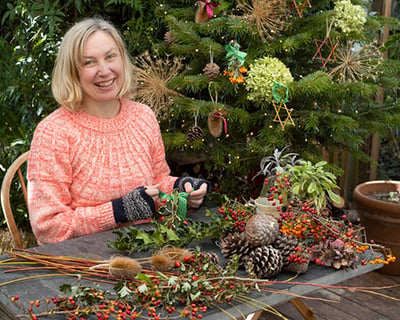Dreaming of a green Christmas
There’s more to Christmas than baubles and tinsel, says Lia Leendertz. She’s been raiding her garden for flowers, fruit and foliage to make the festive season more affordable and planet-friendly
Christmas is synonymous with overindulgence and a groaning belly. We think we’re going to be able to hold out, have a more restrained festive season, but then we crack at the last minute. We buy too much, eat too much and spend the first weeks of January wracked with guilt as we try to cram leftover packaging and wrapping paper into the recycling box, and ourselves into our trousers.
For those of us concerned about our carbon footprint and our bank balance, Christmas excess can all start to feel a bit incompatible, and there’s a strong urge to draw the curtains and pass the season like a hermit.
However, there is another way. I’ve found that Christmas is a celebration that lends itself surprisingly well to an environmentally-friendly, DIY approach. Think, for instance, of the traditional Christmas lunch – turkey with all the trimmings: potatoes, parsnips, Brussels sprouts, carrots, maybe a cauliflower if you’re feeling fancy, plus a bit of gravy. Nearly every mouthful can be grown in our own gardens or sourced in the UK, easily available from fields and farms within a few miles of every home, even in the depths of winter.
Deck the halls
It’s the same with the majority of our decorations. We don’t deck our halls with strelitzias, gerberas and lilies flown in from a southern hemisphere summer, but rather use holly, ivy and mistletoe, all of which are happily weathering our midwinter climate outside right now, and look perfect brought indoors. It can be really magical to replace some of the sparkly tinsel and shiny wrapping paper with home-grown alternatives – harking back to more traditional ways of decorating; I appreciate the gathered bits all the more for having grown them or tracked them down myself. Plus there’s the added benefit that after everything is over, it can all be bundled into the
There are so many ways to extend a home-grown, environmentally-friendly aesthetic to your own plans. Take a bit of time to scour your garden or local hedgerows armed with a bag and pair of secateurs and you’ll quickly have yourself a sack full of interesting shapes and colours: pillowy heads of spent hydrangea flowers; spiky seedheads of echinacea, eryngium, teasel and love-in-a-mist; bright sprigs of rose hips, haws, cotoneaster and pyracantha berries; pine cones and bunches of acorns and acer keys; and the shapely pods of honesty and poppy. Gather some colourful stems of willow and dogwood if you can find them, too.
Avoid spraying these treasures with gold or silver spray paint: you’ll lose their natural beauty and they’ll be uncompostable. Instead, invest in some pretty ribbon to bunch them together and hang them, perhaps in little posies – a seedhead, a stem, a bunch of hips... Coloured willow, bamboo or dogwood stems look delightful fashioned into little stars or hearts to hang on the tree. And the added beauty? You can simply untie everything at the end of the season and save the ribbon for another time!



